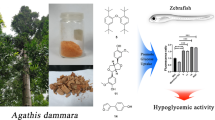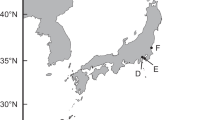Abstract
Eighteen brominated sponge-derived metabolites and synthetic analogues were analyzed for antilarval settlement of Balanus improvisus. Only compounds exhibiting oxime substituents including bastadin-3 (4), −4 (1), −9 (2), and −16 (3), hemibastadin-1 (6), aplysamine-2 (5), and psammaplin A (10) turned out to inhibit larval settling at 1 to 10 μM. Analogues of hemibastadin-1 (6) were synthesized and tested for structure activity studies. Debromohemibastadin-1 (8) inhibited settling of B. improvisus, albeit at lower concentrations than hemibastadin-1 (6). Both 6 and 8 also induced cyprid mortality. 5,5′-dibromohemibastadin-1 (7) proved to be nontoxic, but settlement inhibition was observed at 10 μM. Tyrosinyltyramine (9), lacking the oxime function, was not antifouling active and was non-toxic at 100 μM. Hemibastadin-1 (6) and the synthetic products showed no general toxicity when tested against brine shrimp larvae. In contrast to the lipophilic psammaplin A (10), the hydrophilic sulfated psammaplin A derivative (11) showed no antifouling activity even though it contains an oxime group. We therefore hypothesize that the compound needs to cross membranes (probably by diffusion) and that the target for psammaplin A lies intracellularly.




Similar content being viewed by others
References
Alzieu C, Sanjuan J, Deltreil JP, Borel, M (1986) Tin contamination in Arcachon bay—effects on oyster shell anomalies. Mar Pollut Bull 17, 494–498
Alzieu C, Sanjuan J, Michel P, Borel M, Dreno JP (1989) Monitoring and assessment of butyltins in atlantic coastal waters. Mar Pollut Bull 20, 22–26
Arabshahi L, Schmitz FJ (1987) Brominated tyrosine metabolites from an unidentified sponge. J Org Chem 52, 3584–3586
Armstrong PB, Quigley JP (1999) Alpha(2)-macroglobulin: an evolutionarily conserved arm of the innate immune system. Dev Comp Immunol 23, 375–390
Assmann M, Lichte E, Pawlik JR, Kock M (2000) Chemical defenses of the Caribbean sponges Agelas wiedenmayeri and Agelas conifera. Mar Ecol Prog Ser 207, 255–262
Berntsson KM, Jonsson PR, Lejhall M, Gatenholm P (2000) Analysis of behavioural rejection of micro-textured surfaces and implications for recruitment by the barnacle Balanus improvisus. J Exp Mar Biol Ecol 251, 59–83
Bers AV, Wahl M (2004) The influence of natural surface microtopographies on fouling. Biofouling 20, 43–51
Blunt JW, Copp BR, Munro MHG, Northcote PT, Prinsep MR (2006) Marine natural products. Nat Prod Rep 23, 26–78
Borders DB, Morton GO, Wetzel ER (1974) Structure of a novel bromine compound isolated from a sponge. Tetrahedron Lett 31, 2709–2712
Butler MS, Lim TK, Capon RJ, Hammond LS (1991) The bastadins revisited—new chemistry from the Australian marine sponge Ianthella basta. Austral J Chem 44, 287–296
Carballo J, Hernandez-Inda Z, Perez P, Garcia-Gravalos M (2002) A comparison between two brine shrimp assays to detect in vitro cytotoxicity in marine natural products. BMC Biotech 2, 17–21
Carney JR, Scheuer PJ, Kellyborges M (1993) A new bastadin from the sponge Psammaplysilla purpurea. J Nat Prod 56, 153–157
Cimino G, Derosa S, Destefano S, Self R, Sodano G (1983) The bromo-compounds of the true sponge Verongia aerophoba. Tetrahedron Lett 24, 3029–3032
Clare AS (1996a) Natural product antifoulants: status and potential. Biofouling 9, 211–229
Clare AS (1996b) Signal transduction in barnacle settlement: calcium re-visited. Biofouling 10, 141–159
Dahlström M, Lindgren F, Berntsson K, Sjögren M, Martensson LGE, Jonsson PR, Elwing H (2005) Evidence for different pharmacological targets for imidazoline compounds inhibiting settlement of the barnacle Balanus improvisus. J Exp Zool A 303A, 551–562
Dobretsov S, Dahms HU, Qian PY (2006) Inhibition of biofouling by marine microorganisms and their metabolites. Biofouling 22, 43–54
Fusetani N (2004) Biofouling and antifouling. Nat Prod Rep 21, 94–104
IMO (2001) Resolution on early and effective application of the international convention on the control of harmful antifouling systems on ships. Resolution A928(22) IMO
Jaspars M, Rali T, Laney M, Schatzman RC, Diaz MC, Schmitz FJ, Pordesimo EO, Crews P (1994) The search for inosine 5′-phosphate dehydrogenase (IMPDH) inhibitors from marine sponges—evaluation of the bastadin alkaloids. Tetrahedron 50, 7367–7374
Kazlauskas R, Lidgard RO, Murphy PT, Wells RJ (1980) Brominated tyrosine-derived metabolites from the sponge Ianthella basta. Tetrahedron Lett 21, 2277–2280
Kelly SR, Garo E, Jensen PR, Fenical W, Pawlik JR (2005) Effects of Caribbean sponge secondary metabolites on bacterial surface colonization. Aquat Microb Ecol 40, 191–203
Kobayashi J, Tsuda M, Murayama T, Nakamura H, Ohizumi Y, Ishibashi M, Iwamura M, Ohta T, Nozoe S (1990) Ageliferins, potent actomyosin atpase activators from the Okinawan marine sponge Agelas sp. Tetrahedron 46, 5579–5586
Kotoku N, Tsujita H, Hiramatsu A, Mori C, Koizumi N, Kobayashi M (2005) Efficient total synthesis of bastadin 6, an anti-angiogenic brominated tyrosine-derived metabolite from marine sponge. Tetrahedron 61, 7211–7218
Mack MM, Molinski TF, Buck ED, Pessah IN (1994) Novel modulators of skeletal-muscle Fkbp12 calcium-channel complex from Ianthella basta—role of Fkbp12 in channel gating. J Biol Chem 269, 23236–23249
Meyer BN, Ferrigni NR, Putnam JE, Jacobsen LB, Nichols DE, McLaughlin JL (1982) Brine shrimp—a convenient general bioassay for active-plant constituents. Planta Med 45, 31–34
Miao S, Andersen RJ, Allen TM (1990) Cytotoxic metabolites from the sponge Ianthella basta collected in Papua-New-Guinea. J Nat Prod 53, 1441–1446
Park SK, Jurek J, Carney JR, Scheuer PJ (1994) 2 more bastadins, 16 and 17, from an Indonesian sponge Ianthella basta. J Nat Prod 57, 407–410
Pettit GR, Butler MS, Williams MD, Filiatrault MJ, Pettit RK (1996) Isolation and structure of hemibastadinols 1–3 from the Papua New Guinea marine sponge Ianthella basta. J Nat Prod 59, 927–934
Pham NB, Butler MS, Quinn RJ (2000) Isolation of psammaplin A 11′-sulfate and bisaprasin 11 ′-sulfate from the marine sponge Aplysinella rhax. J Nat Prod 63, 393–395
Pordesimo EO, Schmitz FJ (1990) New bastadins from the sponge Ianthella basta. J Org Chem 55, 4704–4709
Proksch P, Edrada RA, Ebel R (2002) Drugs from the seas—current status and microbiological implications. Appl Microbiol Biot 59, 125–134
Renslo AR, Luehr GW, Gordeev MF (2006) Recent developments in the identification of novel oxazolidinone antibacterial agents. Bioorg Med Chem 14, 4227–4240
Rittschof D, Maki J, Mitchell R, Costlow JD (1986) Ion and neuropharmacological studies of barnacle settlement. Neth J Sea Res 20, 269–275
Shen XY, Perry TL, Dunbar CD, Kelly-Borges M, Hamann MT (1998) Debromosceptrin, an alkaloid from the Caribbean sponge Agelas conifera. J Nat Prod 61, 1302–1303
Sjögren M, Dahlström M, Göransson U, Jonsson PR, Bohlin L (2004a) Recruitment in the field of Balanus improvisus and Mytilus edulis in response to the antifouling cyclopeptides barettin and 8,9-dihydrobarettin from the marine sponge Geodia barretti. Biofouling 20, 291–297
Sjögren M, Göransson U, Johnson AL, Dahlström M, Andersson R, Bergman J, Jonsson PR, Bohlin L (2004b) Antifouling activity of brominated cyclopeptides from the marine sponge Geodia barretti. J Nat Prod 67, 368–372
Thompson JE (1985) Exudation of biologically-active metabolites in the sponge Aplysina fistularis. I Biological evidence. Mar Biol 88, 23–26
Thompson JE, Walker RP, Faulkner DJ (1985) Screening and bioassays for biologically active substances from 40 marine sponge species from San Diego, California, USA. Mar Biol 88, 11–21
Thoms C, Wolff M, Padmakumar K, Ebel R, Proksch P (2004) Chemical defense of Mediterranean sponges Aplysina cavernicola and Aplysina aerophoba. Z Naturforsch (C) 59, 113–122
Tsukamoto S, Kato H, Hirota H, Fusetani N (1996a) Ceratinamides A and B: new antifouling dibromotyrosine derivatives from the marine sponge Pseudoceratina purpurea. Tetrahedron 52, 8181–8186
Tsukamoto S, Kato H, Hirota H, Fusetani N (1996b) Ceratinamine: an unprecedented antifouling cyanoformamide from the marine sponge Pseudoceratina purpurea. J Ogr Chem 61, 2936–2937
Tsukamoto S, Kato H, Hirota H, Fusetani N (1996c) Pseudoceratidine: a new antifouling spermidine derivative from the marine sponge Pseudoceratina purpurea. Tetrahedron Lett 37, 1439–1440
Wahl M (1989) Marine epibiosis. 1 Fouling and antifouling—some basic aspects. Mar Ecol Prog Ser 58, 175–189
Walker RP, Faulkner DJ, Vanengen D, Clardy J (1981) Sceptrin, an antimicrobial agent from the sponge Agelas-Sceptrum. J Am Chem Soc 103, 6772–6773
Xu HH, Chen X, Liao RA, Xie QL (2001) Isolation and crystal structure of 2-bromoaldisin. Chin J Struc Chem 20, 173–175
Xynas R, Capon RJ (1989) 2 New bromotyrosine-derived metabolites from an Australian marine sponge, Aplysina sp. Austral J Chem 42, 1427–1433
Yamamoto H, Satuito CG, Yamazaki M, Natoyama K, Tachibana A, Fusetani N (1998) Neurotransmitter blockers as antifoulants against planktonic larvae of the barnacle Balanus amphitrite and the mussel Mytilus galloprovincialis. Biofouling 13, 69–82
Yamamoto H, Shimizu K, Tachibana A, Fusetani N (1999) Roles of dopamine and serotonin in larval attachment of the barnacle, Balanus amphitrite. J Exp Zool 284, 746–758
Acknowledgments
We thank BMBF (BiotechMarin) for financial support. C. Thoms acknowledges a Feodor Lynen Fellowship by the Alexander von Humboldt-Foundation, Bonn, Germany and P. Schupp acknowledges support by the National Institutes of Health MBRS SCORE grant S06-GM44796.
Author information
Authors and Affiliations
Corresponding author
Rights and permissions
About this article
Cite this article
Ortlepp, S., Sjögren, M., Dahlström, M. et al. Antifouling Activity of Bromotyrosine-Derived Sponge Metabolites and Synthetic Analogues. Mar Biotechnol 9, 776–785 (2007). https://doi.org/10.1007/s10126-007-9029-x
Received:
Accepted:
Published:
Issue Date:
DOI: https://doi.org/10.1007/s10126-007-9029-x




